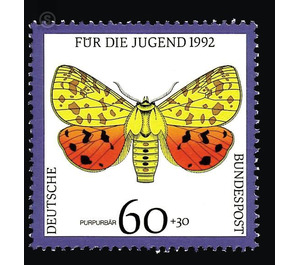youth: endangered moths - Germany / Federal Republic of Germany 1992 - 60 Pfennig
Theme: Animals
| Country | Germany / Federal Republic of Germany |
| Issue Date | 1992 |
| Face Value | 60.00 |
| Color | multi-colored white blue |
| Perforation | K 13 3/4 |
| Printing Type | Multicolor offset printing |
| Stamp Type | Postage stamp |
| Item Type | Stamp |
| Chronological Issue Number | 1475 |
| Chronological Chapter | GER-BRD |
| SID | 893597 |
| In 29 Wishlists | |
Whoever speaks of butterflies usually means the colorful, flower-visiting butterflies that fly in the sunshine during the day, such as the peacock's eye, the little fox or the cabbage white. Few know that about nine-tenths of all butterflies belong to the so-called "moths." However, this is a rather inaccurate (and unscientific) collective term that encompasses everything that is not just "butterflies", a vast, heterogeneous set of at least 150,000 species worldwide, to which about 60 different "families" are assigned (for comparison: butterflies, for example) 13,000 species, 5 families). The only thing they have in common is their nocturnal way of life (and even that is far from being the case in every species, as many have become diurnal again). The fact that they fly around at night, being lured by light sources and sometimes getting into apartments, is probably the main reason why this large group of insects has either remained largely unknown to the layman or even occasional encounters with these "moths" are considered unpleasant, though they are completely harmless. Hardly anyone knows, therefore, the splendor and beauty of many species, at least comparable to the butterflies, or the subtle aesthetics of the other, less conspicuously colored species. There are more than 2,000 species of moths in Germany and of course they are - as well as the butterflies - endangered by human interference in the natural environment and threatened in part their existence. That they, too, are an indispensable and worthy part of a whole, to which, last but not least, man belongs, is to draw attention to the small selection of native moths. The moth family of the "Bear Moth" (Arctiidae), distributed worldwide with about 6,000 species, owes its name to the dense, fur-like hairiness of the caterpillars of most species. Certainly, this peculiarity is an effective protection against many predators. There are z. B. only very few bird species (such as the cuckoo) known that do not disdain such caterpillars. The moths are often characterized by conspicuous wing patterns and very special colors, which is generally interpreted as a warrior costume, so enemies should signal the inedible or even toxicity. The purple bear (Rhyparia purpurata) is one of the approximately 40 domestic bear moth species. North of the low mountain ranges, it is only locally and rarely found, in the south a little more often. The purple bear prefers warm, not too dry biotopes, forest clearings, open slopes and heathlands. The white-gray, on the back fuchsrot hairy caterpillar lives from August - overwintering - to May on various herbaceous plants and bushes, such. B. Lab herb (Galium), blackberry and broom. The moth flies in June and July, the male also during the day. Hazard factors: Intensification measures in agriculture, land consolidation, over-fertilization of pastures, application of herbicides, reforestation of forest clearings, etc.


